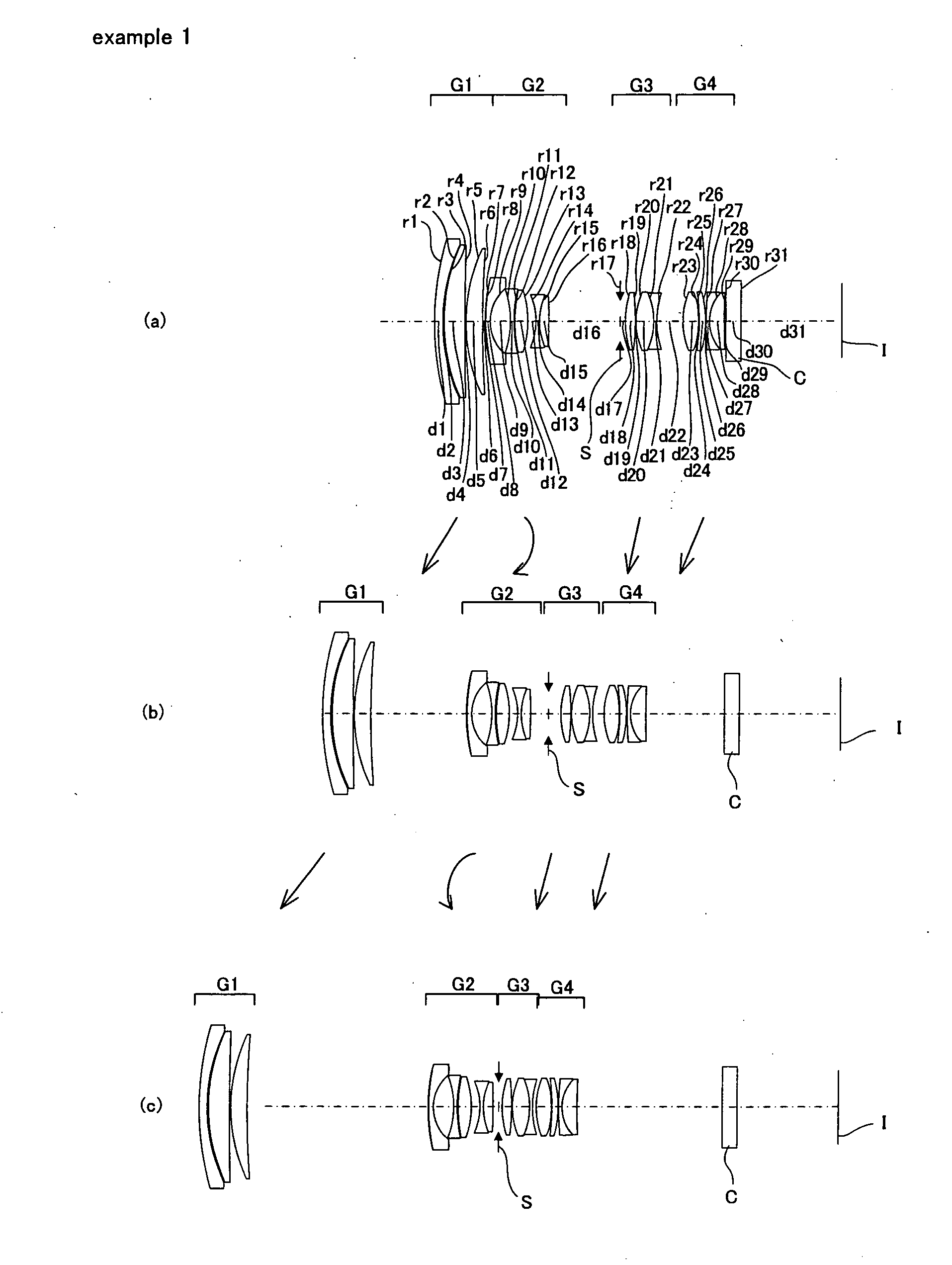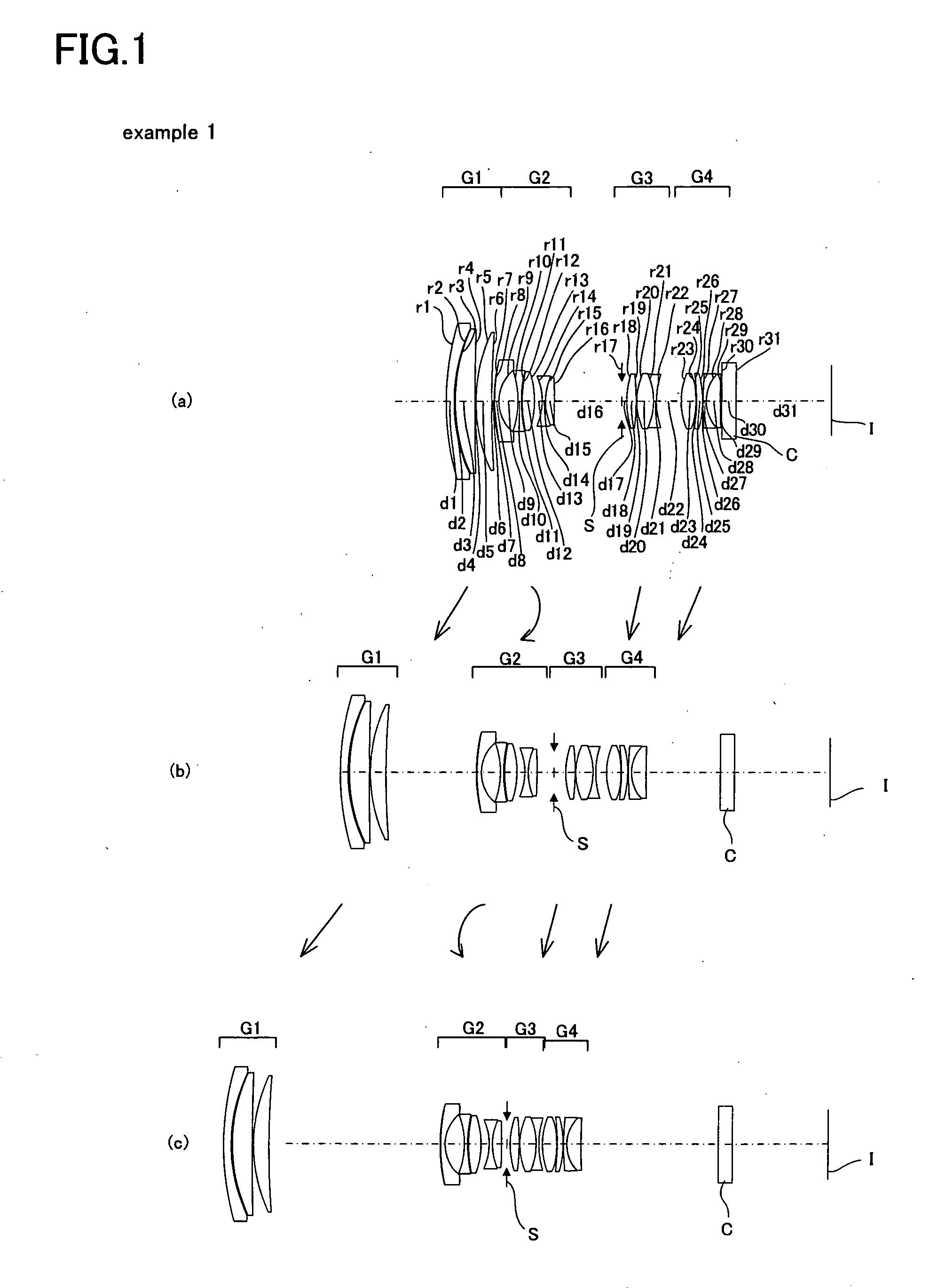Zoom lens
- Summary
- Abstract
- Description
- Claims
- Application Information
AI Technical Summary
Benefits of technology
Problems solved by technology
Method used
Image
Examples
example 1
Numeric Example 1
[0246]
Unit mmSurface dataSurface Numberrdndνd 190.6182.651.8502632.27 256.5480.45 358.7316.501.4970081.54 41683.6700.20 552.5335.201.4970081.54 6273.171variable 7 (Aspheric)90.8060.081.5194051.94 863.5731.401.8830040.76 913.0496.4810−27.4611.051.6031160.641140.6690.201240.5954.201.6889331.0713−28.664variable14−19.2081.001.6968055.531519.9383.101.8010034.9716−132.991variable17 (Stop)∞1.501828.9003.001.4970081.5419−83.0430.202022.3595.451.5826746.4221−22.2651.001.8061040.922227.235variable23 (Aspheric)20.2294.791.4970081.5424 (Aspheric)−31.0550.2025−52.4551.931.4970081.5426−33.3760.2027119.3221.001.7859044.202812.8714.601.5163364.1429339.930variable30∞4.571.5163364.1431∞31.02 Image Surface∞Aspheric data7 surfaceK = −130.000, A4 = 4.52900E−05, A6 = −2.36519E−07,A8 = 9.84174E−10, A10 = −1.91016E−1223 surfaceK = −0.858, A4 = −2.86800E−05, A6 = −2.37382E−07,A8 = −7.90089E−11, A10 = 3.47390E−1224 surfaceK = 0.000, A4 = −8.53186E−06, A6 = −3.03923E−07,A8 = 1.88936E−09, A10 ...
example 2
Numeric Example 2
[0247]
Unit mmSurface dataSurface Numberrdndνd 166.3282.651.8502632.27 245.4360.25 345.2507.001.4970081.54 4299.8000.20 563.1764.701.4970081.54 6335.857variable 7 (Aspheric)481.6670.081.5194051.94 886.8621.401.8830040.76 913.4365.9010−28.5371.051.6968055.531113.6370.011.5638460.701213.6376.001.7950428.5713−40.7991.8914−15.2621.001.6584450.8815−27.963variable16 (Stop)∞1.511730.2723.001.4970081.5418−62.6920.201934.2974.641.5831359.3820−19.0381.001.8040046.572144.212variable22 (Aspheric)20.0253.891.4970081.5423 (Aspheric)−60.9381.5024−65.7162.841.5163364.1425−31.1160.272690.0451.001.7880047.372712.2165.501.5163364.1428−234.323variable29∞4.571.5163364.1430∞31.02 Image Surface∞Aspheric data7 surfaceK = −8.762, A4 = 3.71514E−05, A6 = −1.08617E−07,A8 = 4.69314E−10, A10 = −5.72623E−1322 surfaceK = −0.419, A4 = −2.44119E−05, A6 = −1.87312E−07,A8 = 1.09982E−09, A10 = −3.00750E−1223 surfaceK = 0.860, A4 = −1.09348E−05, A6 = −1.78033E−07,A8 = 1.65893E−09, A10 = −4.96813E−1228 su...
example 3
Numeric Example 3
[0248]
Unit mmSurface dataSurface Numberrdndνd 1102.2392.651.8502632.27 260.4690.44 362.8396.301.4970081.54 4−5475.1940.20 553.6205.401.4970081.54 6291.069variable 7 (Aspheric)2010.5150.081.5194051.94 8100.8871.401.8830040.76 913.4345.9010−28.7831.051.6968055.531113.4980.011.5638460.701213.4986.001.7950428.5713−39.7051.8714−15.3751.001.6779050.7215−27.190variable16 (Stop)∞1.941728.9823.101.4970081.5418−66.7310.201935.6154.671.5831359.3820−18.5451.001.8040046.572143.986variable22 (Aspheric)19.5304.101.4970081.5423 (Aspheric)−48.8152.1024−50.5231.691.5163364.1425−30.8950.222688.1441.001.7880047.372712.1175.501.5163364.1428 (Aspheric)−260.135variable29∞4.571.5163364.1430∞31.02 Image Surface∞Aspheric data7 surfaceK = −99.589, A4 = 3.84229E−05, A6 = −1.00234E−07,A8 = 3.42734E−10, A10 = −3.08633E−1322 surfaceK = −0.410, A4 = −2.51348E−05, A6 = −1.87930E−07,A8 = 1.09632E−09, A10 = −2.41077E−1223 surfaceK = 0.921, A4 = −1.09550E−05, A6 = −1.77210E−07,A8 = 1.69378E−09, A10 = ...
PUM
 Login to View More
Login to View More Abstract
Description
Claims
Application Information
 Login to View More
Login to View More - R&D
- Intellectual Property
- Life Sciences
- Materials
- Tech Scout
- Unparalleled Data Quality
- Higher Quality Content
- 60% Fewer Hallucinations
Browse by: Latest US Patents, China's latest patents, Technical Efficacy Thesaurus, Application Domain, Technology Topic, Popular Technical Reports.
© 2025 PatSnap. All rights reserved.Legal|Privacy policy|Modern Slavery Act Transparency Statement|Sitemap|About US| Contact US: help@patsnap.com



